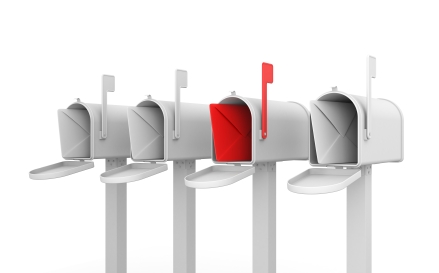 If you are nervously wondering whether you and I need to have a ‘deep and meaningful’ conversation, don’t worry. I am referring to another type of DM – the kind that allows you to talk directly to your customers – Direct Marketing (DM).
If you are nervously wondering whether you and I need to have a ‘deep and meaningful’ conversation, don’t worry. I am referring to another type of DM – the kind that allows you to talk directly to your customers – Direct Marketing (DM).
The subject of DM seems to polarise opinion. There are those who wrinkle their nose up in disgust, and file the idea of DM campaigns along with the junk mail contents of the nearest recycling bin. Other, more enlightened marketeers will consider DM on its merits – as a viable means of having a more personalised conversation with their customers.
Used correctly, direct marketing has several uses, and a well-planned, targeted direct mail campaign can increase brand recognition and significantly boost lead generation.
The umbrella term of direct marketing, encompasses direct mail, email campaigns, advertising, telephone sales (telemarketing), catalogues, leaflets, brochures, coupons, mobile messaging, interactive consumer websites and online display/banner advertisements.
Success or failure of these campaign is largely down to the targeted nature of the message and the relevance of the prospect databases used.
DM can be a very cost-effective sales tool for specialised companies, as long as it is used properly and sparingly. Care must be taken to respect the laws that surround Data Protection/Security, the ‘Do not call’ list, and the consumer’s right to unsubscribe from unsolicited emails.
DM as part of the overall communications strategy
DM (such as direct mail or email campaigns) can work well as a stand alone, but it is much more effective when used in synergy with other channels. For example if you use direct mail alongside a TV or press campaign, you are going to significantly increase the impact of the campaign as a result of continuously re-enforcing the same brand and messaging from different touch points.
The pros of DM
- For many companies or service providers with a specific market, the traditional forms of advertising (radio, newspapers and television, ) may not be the best use of their promotional budgets. Instead of investing in a spray and scatter approach, DM can be sent straight to a list of ‘pre-screened’ individuals.
- DM (and direct mail in particular) enables customers to spend time with your information. With a little imagination, it creates much more impact than people realise. It puts your brand and messaging directly into the hands of customers – and that is what marketing is all about.
- It helps develop and maintain strong personal relationships with their customers and prospects . This is particularly useful as your company grows. Customers want you to speak to them in as personal a way as possible, which is what direct mail offers. Direct mail helps make customers feel more ‘valued’.
- It’s one of the easiest marketing tools to evaluate.
- The key to any campaign is ensuring your message is relevant – this means targeting the right people,in the right way. If you know enough about your existing customer base, you can build your own mailing lists for lead generation campaigns. You can also buy lists of potential customers. Data is a challenge every company struggles with and it’s essential to get the targeting right.
- DM is the perfect tool for up-selling. If you are keeping good databases and tracking customers, you will know when a particular group may want a product upgrade or benefit from a value-added service.
- It is a fantastic tool in any customer development strategy.
- You can address challenges or issues in a very targeted mailing. DM is about reaching out and having that personal touch. Customers are valuing that more and more these days.
The cons of DM
- Expensive: The costs of designing effective direct mail advertisements or direct marketing campaigns, can be high, especially if you are engaging the services of professional creatives. Paying a printing company to produce fliers or brochures can also be expensive, especially when the costs of paper and ink are high. To be effective, direct mail campaigns must be targeted with up-to-date mailing lists. These are usually purchased from list management companies or brokers, and the cost per 1000 names can vary significantly. In most cases, “one shot” mail marketing does not produce desired results. Multiple mailings over a period of time are the norm, and the accumulation of mailing costs can climb quickly – even when special ‘bulk rate discounts’ apply.
- Junk mail is annoying: There’s no getting away from it. Direct mail is perceived as “junk” to many people. As I hinted at earlier, the majority of ‘junk mail’ is disposed off immediately, Those that do read it may end up feeling annoyed, which would cast a negative light on the company and aggravate or even upset potential customers. To understand the importance of an up-to-date mailing list, imagine receiving mail for a loved one in the house-hold who has recently died. It’s upsetting to say the least. Imagine if it was your company that upset them.
- Low response rates: In the direct mail industry average success rates range from 1 to 2 percent, and that is if they are successful. To recover the costs of the campaign and make a profit, you may have to distribute tens of thousands of direct mail advertisements.
- Long lead times : The timing of distribution is often crucial to direct mail campaigns, however, it can be difficult to predict how long it will take to get your advertisement from the design phase through production and into the customer’s hand. It can sometimes take longer than one or two weeks to produce your advertisement, depending on the complexity of the design and the material used, and then there is the imprecision of mail delivery times to consider.
- Data protection: Many people are concerned about how the personal information they include on an order form or survey may be used fat a later date. There is also concern that personal information collected by legitimate direct marketing agencies could be purchased by unscrupulous or shady companies for fraudulent activities.
- Environmental Implications: Though some of the direct mail materials used today are made with environmentally friendly, 100-percent recycled materials, many are not. When you consider that you will likely be producing thousands of advertisements, 98 to 99 percent of which will be trashed, the environmental implications are not positive. Some customers object to direct mail advertisements for this reason more than any other.
So by now you have weighed up some of the pros and cons, but from a writing perspective, what are the important things you must consider? Well, it’s basic information I know, but knowing your audience is a MUST.
Simple formula
If you keep these four points in mind you won’t go far wrong: attention, interest, desire and call to action. Your copy must be an attention seeking, limelight grabber. Use a strong headline that states your selling proposition. Follow this up by creating interest in your solution. Perhaps you could outline a problem your prospect may have, then position your solution as the answer to that problem. Create desire (and credibility) for what you are selling by using testimonials and photographs. The call to action is the vital element – you want your customer to react NOW, so make sure you have provided a call to action with the correct contact details or drive them to your website address. Move them along to the next phase of the buyer’s journey – but make sure you don’t shove them off the train completely. Good luck.
 Send to Kindle
Send to Kindle

